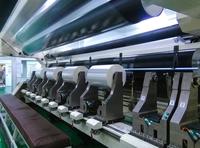Film Slitter Factory Introduces Static Electricity Removal Requ
-
As the speed of the slitting machine becomes faster and faster, the strong friction between the insulating polymer film material and the rubber roller and the metal roller during the slitting process will generate a lot of static electricity, which will easily attract dust to the material and affect the quality of the film roll. , especially on the pattern of some printed films. The mutual attraction and repulsion between static electricity will cause relative displacement between the film layers, resulting in a series of winding problems such as slippage, slitting offset, tension change and so on. What's more, severe friction will generate an ultra-high potential of hundreds of thousands of volts, which may cause air discharge and directly cause a fire, or electric shock to the operator, resulting in injury accidents. Regardless of production safety or production efficiency, the static electricity generated by film slitting and winding is extremely harmful.
At present, the technique of installing static elimination products at the winding place is generally used to solve this problem. Film Slitter Factory introduced that there are two common methods of static elimination, active and passive. Passive elimination methods include static elimination ropes, static brushes, static copper wires, etc., which are an economical and effective solution, especially where active static elimination equipment cannot be used. The method of use is generally to use conductive fibers close to the surface of the material to form an electric field and ionize the nearby air to achieve the purpose of neutralizing the electrostatic charge of the target. Active classic elimination generally uses ion rods to generate a large number of positive and negative charges to neutralize the static electricity on the surface of the material. Here, it should be noted that the center winding static rod is generally installed above or below the winding shaft, and the surface winding is generally installed when the film leaves the pressure roller. On the other side, the dual position winder needs to be installed where it can handle two different winder positions.
Through the above introduction, Paper Slitter Factory hopes that you can simply refer to the content of this article in future use.

